Sarasota-Bradenton International Airport (SRQ)
Sarasota/Bradenton International Airport (SRQ) is a primarily business and general aviation airport with modest air taxi/air carrier operations. Located on Florida's west coast and some 30 miles south of the larger Tampa International Airport, SRQ is a convenient starting point for international business and GA flights. FBOs are located on the north, east and west sides of the airport and the passenger terminal is located to the south. View a printable Pilot Handbook of the SRQ information found on this Web page.
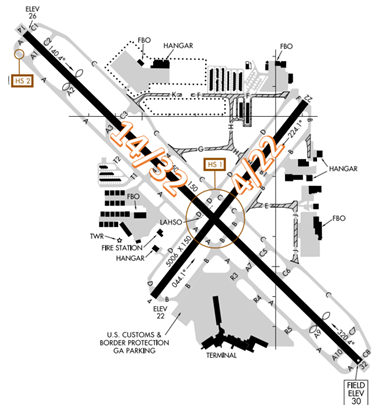
SRQ ATCT operates 0600L-2400L
Administrative Office open 0730L to 1530L M-F
Business Phone 941-556-3500
The airport configuration consists of intersecting RWYs 14/32 and 4/22.
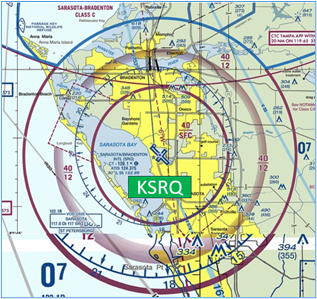
The airspace at SRQ is Class C. (Refer to Sectional Chart)
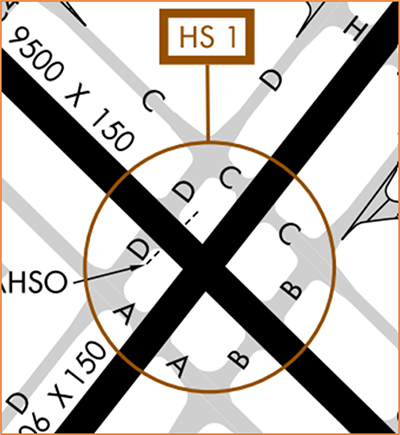
Hot Spots
HS 1 Be alert to multiple TWY and RWY crossing points surrounding the intersection of RWY 14/32 and RWY 4/22.
- This area encompasses four intersecting TWYs and two intersecting RWYs, increasing the risk for a runway incursion.
- There are numerous Runway Holding Position Markings/Signage in this area. Pilots sometimes fail to hold short at the appropriate location even after acknowledging the instructions from ATC. Actively scanning to locate and identify RWY signs, markings, lighting and deferring all heads down activities until holding short at the appropriate location will help eliminate these errors.
- If you are unsure of your position or instructions, don’t risk it. Ask the tower!
HS 2 RWY incursion risk. RWY 14 and TWY A. Runway Holding Position Markings further from runway than expected.
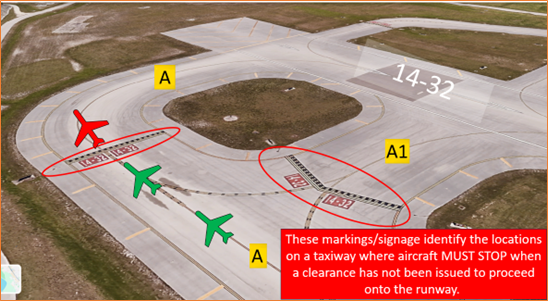
- Pilots instructed RWY 14 taxi via TWY A sometimes miss the hold short line and make the turn towards the runway.
- Pilots may not be expecting to encounter the hold short position which is located on TWY A prior to making the turn to RWY 14. It is imperative to review the taxi route prior to taxiing.
- View the From the Flight Deck – Complex Airfield Geometry#7: Hold Short Lines In Unexpected Places for additional information.
Wrong Surface RWY Landing Risks
- TWY A parallels RWY 14/32. Pilots on approach sometimes align with TWY A which may result in a wrong surface landing.
- If available, back up all visual approaches with an instrument approach or GPS Waypoint to help ensure that you are lined up for the correct surface.
- RWY markings are white. Markings on surfaces not used for takeoff/landing like TWY markings, chevrons, RWY shoulder and RWY turn-on markings etc., are yellow.
- View the From the Flight Deck-Wrong Surface Landings video for additional mitigation strategies.
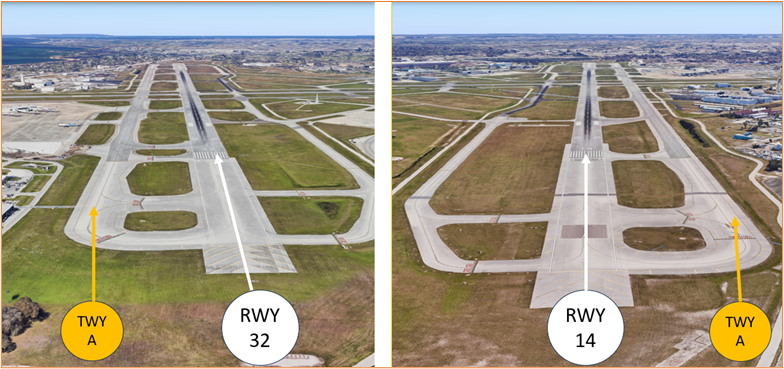
Surface Risk – Movement Area Cautions
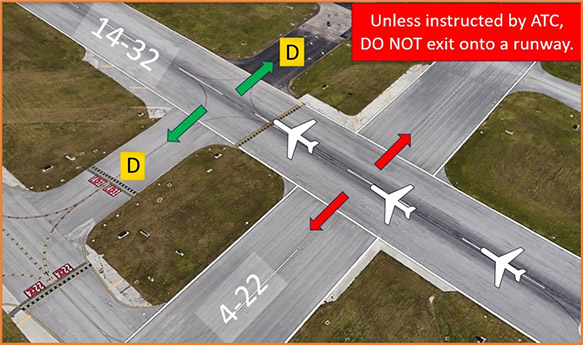
- During landing rollout on RWY 32, pilots instructed to turn left or right on TWY D have mistakenly turned onto RWY 4/22.
- Pilots must be aware that an intersection departure presents the risk of taking off in the wrong direction.
- The following illustration depicts the intersection of RWY 32 at TWY A3. If approaching the RWY from the opposite side, the RWY markings will have the numbers reversed.
- Prior to entering the RWY and again when lining up on the RWY, check your Magnetic Compass and your Horizontal Situation Indicator (HSI), if installed, to verify that you are pointed in the correct direction.
- View the From the Flight Deck-Wrong Direction Intersection Takeoffs video for more information and mitigation strategies.
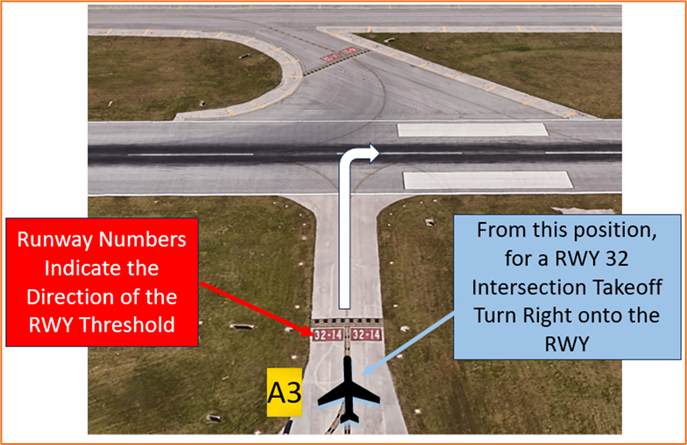
General
- SRQ is the home of five different flight schools, and we ask that pilots be aware of our student pilots and try to be vigilant while we have training in the airspace. It is imperative that students and instructors maintain consistent situational awareness, understanding that SRQ has an increased volume of jet traffic, including air carriers, which results in higher complexity within the airspace.
- We also ask that practice approaches and tower pattern work be accomplished early in the morning or later in the evening. SRQ becomes very busy with jet traffic between the hours of 0900L-1800L, making it very difficult to accommodate practice approaches and tower pattern work.
- It is an FAA requirement for us to ensure the accuracy of complete readbacks. If you are asked to repeat something, understand we are ensuring compliance with FAA orders.
- We are training too! The FAA has designated SRQ ATCT as a training facility, which means we have increased on-the-job training being conducted regularly. We understand that student pilots need the opportunity to learn, however, if readbacks and compliance with instructions are becoming overly delayed, please step in to avoid frequency congestion and delays to other aircraft.
- Please be aware of ongoing construction at SRQ that is resulting in current taxiway closures and will result in the renaming of multiple taxiways in the future
Ground Control
- Terminal Ramp is uncontrolled, do not call for push/power-back. Call Ground control after push back is complete and you are ready for taxi.
- Ensure you are listening to the ATIS completely for frequency assignment as it will state if aircraft will be issued clearances via Ground Control on 121.9 or Clearance Delivery on 118.25.
Traffic Patterns
- Tower pattern work will normally be conducted on RWY 4/22, and pilots can expect a closed pattern with downwind legs over the approach end numbers of RWY 14/32.
Departure/Takeoff
- Follow current published departure procedures
- Do not turn prior to the departure end of the runway
Arrival/Landing
- VFR aircraft must contact Tampa Approach Control to be sequenced into SRQ.
- Land and Hold Short (LAHSO) clearances may be issued to general aviation aircraft. Advise if you are unable to participate.
LDG RWY
RWY 14
HOLD-SHORT POINT
4/22
AVBL LDG DIST
3800
- When exiting any runway, you are not clear of the runway environment until your aircraft is completely past the hold short bars. If you are unable to pull past the hold short bars, let the tower know immediately.
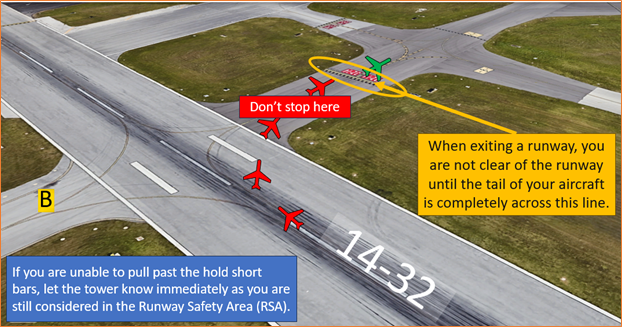
Special Traffic
- One Saturday each month, the Young Eagles program flies out of SRQ and does tours along the coast. We can have up to 12-15 aircraft on any given Young Eagles Saturday. We ask pilots to be aware as we will be unable to accommodate additional practice approaches or tower pattern work on these Saturdays.
